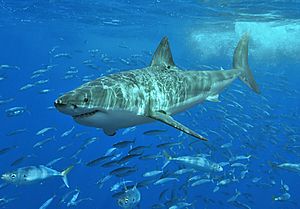Elasmobranchii facts for kids
Quick facts for kids Elasmobranchii |
|
|---|---|
 |
|
| Great white shark (Carcharodon carcharias) |
|
| Scientific classification |
|
| Kingdom: | Animalia |
| Phylum: | Chordata |
| Class: | Chondrichthyes |
| Subclass: | Elasmobranchii Bonaparte, 1838 |
| Superorders | |
Elasmobranchii (say: ee-LAZ-mo-BRANK-ee-eye) is a special group of fish. It includes all the modern sharks, rays, and skates. These amazing creatures are different from most fish because their skeletons are made of cartilage, not bone. Cartilage is a strong, flexible material, like what you have in your nose or ears. This is why they are called cartilaginous fish.
Unlike many bony fish, elasmobranchs do not have a swim bladder. A swim bladder helps fish float. Instead, these sharks and rays stay afloat using a lot of oil stored in their livers. Some deep-sea sharks, like the school shark, gulper shark, and basking shark, are sometimes caught for this special liver oil. Sadly, these three species are now considered vulnerable because too many of them have been caught. This is called overfishing.
Ancient History
The oldest known shark teeth are about 400 million years old. This was during a time called the Devonian Period. Sharks started to become very diverse during the Carboniferous Period, which came after the Devonian. Many new types of sharks appeared then.
Some of these ancient sharks died out during the Permian Period. But the sharks that survived then had another big burst of new forms during the Jurassic Period. This was around the same time that rays and skates first appeared.
Shark and Ray Families
Scientists group elasmobranchs into different families. The two main groups are sharks and rays.
- Subclass Elasmobranchii
- Infraclass Euselachii (this group includes all modern sharks and rays)
- Division Neoselachii
- Subdivision Selachii (these are the modern sharks)
- Division Neoselachii
- Infraclass Euselachii (this group includes all modern sharks and rays)
*Superorder Galeomorphi (this group includes many well-known sharks) **Order Heterodontiformes (like bullhead sharks) **Order Orectolobiformes (like carpet sharks) **Order Lamniformes (like mackerel sharks, including the great white shark) **Order Carcharhiniformes (like ground sharks) *Superorder Squalomorphi (this group includes other types of sharks) **Order Hexanchiformes (like frilled and cow sharks) **Order Squaliformes (like dogfish sharks) **Order Squatiniformes (like angel sharks) **Order Pristiophoriformes (like sawsharks)
-
-
-
- Subdivision Batoidea (these are the rays and skates)
-
-
**Order Torpediniformes (like electric rays) **Order Pristiformes (like sawfishes) **Order Rajiformes (like skates) **Order Myliobatiformes (like stingrays and their relatives)
Protecting Elasmobranchs
Elasmobranchs grow slowly and have few babies. This makes them very sensitive to overfishing. When too many are caught, their populations can drop quickly. This is similar to how marine turtles and whales have faced problems. Protecting these amazing creatures is very important for the health of our oceans.
Images for kids
See also
 In Spanish: Elasmobranquios para niños
In Spanish: Elasmobranquios para niños



